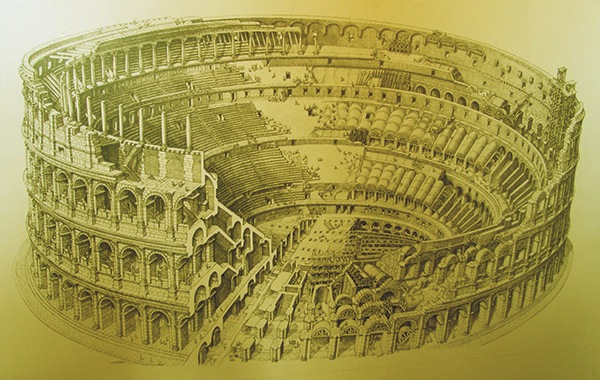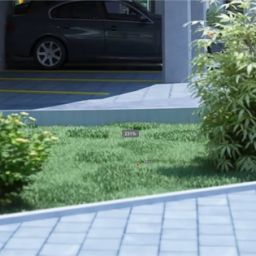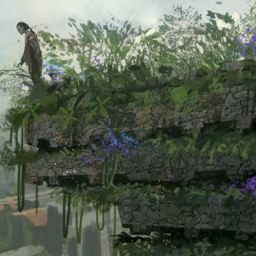
Mention the Colosseum to anybody of the modern cinematic age and most would visualize Russell Crowe in full battle mode in the Hollywood blockbuster Gladiator.
But such is the magnificence of the Colosseum that it needs no Hollywood makeover to attract millions of visitors from across the globe who stop and stare in awe at the sight of the historic Roman amphitheatre.
Continuing on his Italian travels, Chronos Studeos’ friend Sen Debo Adeaga Brown (chief servant and founder of Animation West Africa) stopped off at the Colosseum. Thankfully for us, he’s kindly allowing ourselves and Chronos Studeos’ legion of fans to enjoy his photo album.
Housed on the Palatine Hill in Rome, it isn’t only the sheer size and history of the Colosseum that is difficult for the modern mind to comprehend.
The building of the Colosseum was started at the behest of the Flavian emperors between 70 and 72 CE, hence its more formal name of the ‘Flavian Amphitheater’.
GET YOUR HEAD AROUND THIS! It’s estimated that around 100,000 cubic metres of marbles was used in the construction of the Colosseum
Displaying a desire to honour his own humble path to the throne, the ruler, Vespasian, who was the founding father of the Flavian dynasty – decreed that a Colisseum which could be opened to thousands of normal Roman citizens should be erected for his future successor, Titus, on the very ground which had previously hosted Nero’s palatial Golden House palace.
The destruction of architectural structures built during the tyrannical Nero’s reign didn’t stop here.
The building of the Colosseum also saw the removal of an ostentatious, artificial lake which had been the centrepiece of Nero’s palace complex.
It was during the reign of Titus that the Colosseum was officially dedicated in 80 CE.
The opening was celebrated by thousands of Romans who were encouraged to take part in no less than 100 days of games. The competitors were cheered on by a staggering capacity audience of around 50,000 spectators who accessed the arena via one of its 80 entrances.
The inaugural games alone resulted in the slaughter of approximately 9,000 animals. However, this is nothing when compared to the ultimate death toll from inside the Colosseum.
Historians estimate that around 500,000 people and over 1,000,000 animals were ultimately slaughtered after entering what is undoubtedly the world’s most violent arena of ‘entertainment’.
FANCY THAT! The name of the Colosseum is derived from the statue of Colossus which formed part of Nero’s Park complex where the amphitheatre was built
Although the Colosseum also hosted executions, it wasn’t purely the scene of bloodshed.
The amphitheater also played host to a wide range of events, including the re-enactments of historic battles and dramas.
All those watching the live action were protected from the dazzling sun by a huge, retractable velarium (or awning).
In 82, during the reign of Domitian, the Colosseum was extended to incorporate the uppermost story.
Perhaps the most striking element of the Colosseum is the fact it is a freestanding structure consisting of stone and concrete. Measuring a staggering 620 feet by 513 feet (189 by 156 metres), the way the Colosseum was built is almost unique in that the majority of early amphitheaters were dug into hillsides so as to give the massive structure extra support.
The outer walls of the Colosseum were set without mortar. Instead, the 100,000 cm of travertine stones were held together by 300 tonnes of iron clamps.
DID YOU KNOW? The marble facade and other elements of the Colosseum were later used in the construction of St Peter’s Basilica and a number of other national monuments.
While we recently explored just what gave the Leaning Tower of Pisa its famous tilt, for centuries visitors may have mused why we’ve been left with, essentially, a partly collapsed Colosseum.
Sadly, Mother Nature had other plans for the original building’s longevity. In 847 a devastating earthquake hit the region, resulting in the collapse of the southern side of the amphitheater.
Meanwhile, human rather than natural vandalism resulted in the destruction or disappearance of all of the original marble seats and decorative materials.
But while the Colosseum is today respectfully treated as a global treasure, for more than 1,000 years it was little more than a quarry. Thankfully, though, successive generations of public figures, from the Pope down, oversaw extensive renovation work so as to protect the Colosseum for future generations.
Nevertheless, the Colosseum will forever be associated in our minds with deadly gladiatorial fights. However, the reality is that the last of these actually took place inside the Colosseum in 435 CE.
Less than a century later the decision was taken by the powers-that-be to also end the animal hunts. The reason? Simple economics, for it was deemed too expensive to procure gladiators and animals.
WOW! Enough to elicit gasps of awe from even the most hardened traveller, the Colosseum is 48 meters high, while the area of its elliptical base is a staggering 24,000 m2
Today, the only expensive acts booked to appear at the Colosseum are some of the world’s richest entertainers.
While towering music industry figures such as Sir Elton John, Ray Charles, and former Beatle Sir Paul McCartney are amongst those to have played to a packed Colosseum, not even they could ever outshine the amphitheater which is today Rome’s most popular visitor attraction and a reminder to us all of the vital and often colourful role architecture plays in the world around us.
Photo Credits :: Sen Debo Adeaga Brown (Chief Servant and Founder of Animation West Africa)


























Amazing to read the history and story behind this magnanimous piece of arts… one need to be there to be able to fathom the gravity and extent of architectural wonder and intention set upon the earth called the Colosseum.
At 12 euro per person, which also covers a visit to the place called ‘the bath” just a few meters walk from here the Colosseum is surely a place to visit and allow yourself get immersed in the imagination of the glory and power that the Romans wielded those years past but not without also considering the vast number of helpless victims consumed by lions and all sorts of wild animals for the amusement and entertainment of many yet few.